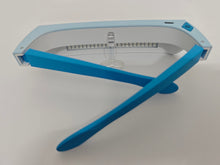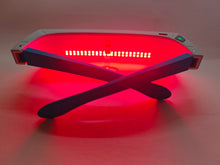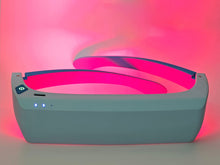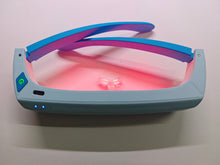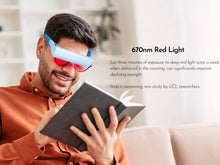




Red Light Therapy Glasses 670nm – Eye Health & Vision Support
Advanced 670nm Red Light Therapy Glasses – Vision & Eye Support
Researchers at University College London (UCL) found that a daily 3-minute exposure to 670 nm deep red light improved vision in adults over 40—especially their color contrast sensitivity and ability to see in dim light.
Enhance your eye health naturally with our 2025 Upgraded Red Light Therapy Glasses 670nm. Specially designed for gentle, non-invasive eye wellness, these glasses use targeted 670nm red light to help:
✔️ Support cellular energy in the eyes
✔️ Promote overall eye comfort and relaxation
✔️ Reduce eye strain & fatigue from screens and daily stress
✔️ Support vision wellness and healthy aging of the eyes
✔️ Safe irradiance level (~2 mW/cm²), comfortable for regular use
Our glasses are lightweight, portable, and easy to use at home or on the go. Many users find them helpful for maintaining daily eye comfort and supporting long-term eye health.
⚠️ Please note:
Our red light therapy glasses are designed to gently support eye health and comfort using safe, low-intensity 670nm light. They are not medical devices and will not cure or reverse conditions like cataracts, glaucoma, or myopia.
Research shows that 670nm light can be beneficial for vision wellness:
-
Scientists at University College London found that just 3 minutes of 670nm red light daily improved declining eyesight in people over 40.
-
Other studies suggest this wavelength helps energize retinal cells and reduce age-related vision decline.
While they cannot replace medical treatment, many users find these glasses helpful for eye comfort, reduced strain, and vision support.
✦ Total LEDs: 40
✦ Targeted Coverage: Eyes
✦ Wavelength: Medical Grade 670nm
✦ Irradiance: 2mW/cm2 at surface
✦ EMF: 0 UT
✦ Built-in Battery: 300mAh / 3.7V
✦ 3-Level Timer: 10min, 15min, 20min
1. UCL Study – Mitochondrial Boost & Improved Vision in Ageing Eyes
-
Researchers at University College London (UCL) found that a daily 3-minute exposure to 670 nm deep red light improved vision in adults over 40—especially their color contrast sensitivity and ability to see in dim light
-
A follow-up study revealed that a single 3-minute exposure in the morning produced up to 17% improvement in color contrast, with benefits lasting at least one week
2. Dry Age-Related Macular Degeneration (AMD) – Short-Term Benefits
-
In a small clinical trial of 10 patients with dry AMD, multiple sessions of 670 nm LED photobiomodulation led to significant improvements in:
-
Best-corrected visual acuity (VA) (from ~1.1 to ~0.98 LogMAR)
-
Visual field sensitivity metrics
No adverse events or abnormal retinal imaging were observed during follow-up PubMed.
-
3. Intermediate AMD – Mixed Results
-
A year-long pilot study involving 31 participants with intermediate AMD and 11 healthy older adults found:
Preclinical & Animal Research: Underlying Mechanisms
-
-
Mitochondrial Support & Anti-Inflammatory Effects
Numerous studies show 670 nm light:-
Enhances mitochondrial function, increasing ATP (cellular energy) production
-
Upregulates cytochrome C oxidase and reduces inflammation in retinal tissue
-
-
Retinal Protection & Wound Healing
In animal models, 670 nm LED therapy helped:-
Mitigate laser-induced retinal injury
-
Protect against methanol-induced retinal damage by enhancing cell survival and mitochondrial resilience PMC.
-
-
Diabetic Retinopathy Model (Rats)
Low-level 670 nm laser therapy in diabetic rats reduced inflammation and oxidative stress, supporting retinal health PMC.
-
1. Use of 31P magnetisation transfer magnetic resonancespectroscopy to measure ATP changes after 670 nmtranscranial photobiomodulation in older adults
Elizabeth J. Fear1,2 | Frida H. Torkelsen3 | Elisa Zamboni4,5 | Kuan-Ju Chen3 |Martin Scott4,6 | Glenn Jeffery7 | Heidi Baseler1,4 | Aneurin J. Kennerley3,8
2. Weeklong improved colour contrasts sensitivity after single 670 nm exposures associated with enhanced mitochondrial function
Shinhmar, H; Hogg, C; Neveu, M; Jeffery, G; (2021) Weeklong improved colour contrasts sensitivity after single 670 nm exposures associated with enhanced mitochondrial function. Scientific Reports , 11 (1) , Article 22872. 10.1038/s41598-021-02311-1.
3. A Pilot Study Evaluating the Effects of 670 nm Photobiomodulation in Healthy Ageing and Age-Related Macular Degeneration
Apr 2020JOURNAL OF CLINICAL MEDICINE9(4):13 pagesMDPI
Co-authors:Grewal MK, Sivapathasuntharam C, Chandra S, Gurudas S, Chong V, Bird A, Jeffery G, Sivaprasad S
4. Aging retinal function is improved by near infrared light (670 nm) that is associated with corrected mitochondrial decline.
Sivapathasuntharam, C; Sivaprasad, S; Hogg, C; Jeffery, G; (2017) Aging retinal function is improved by near infrared light (670 nm) that is associated with corrected mitochondrial decline. Neurobiol Aging , 52 pp. 66-70. 10.1016/j.neurobiolaging.2017.01.001.
5. Optical monitoring of retinal respiration in real time: 670 nm light increases the redox state of mitochondria
Kaynezhad, P; Tachtsidis, I; Jeffery, G; (2016) Optical monitoring of retinal respiration in real time: 670 nm light increases the redox state of mitochondria. Experimental Eye Research , 152 pp. 88-93. 10.1016/j.exer.2016.09.006.
6. Treatment with 670 nm light up regulates cytochrome C oxidase expression and reduces inflammation in an age-related macular degeneration model.
Begum, R; Powner, MB; Hudson, N; Hogg, C; Jeffery, G; (2013) Treatment with 670 nm light up regulates cytochrome C oxidase expression and reduces inflammation in an age-related macular degeneration model. PLoS One , 8 (2) , Article e57828. 10.1371/journal.pone.0057828.
7. Age-related retinal inflammation is reduced by 670 nm light via increased mitochondrial membrane potential.
15 May 2012Neurobiol Aging
Co-authors:Kokkinopoulos I, Colman A, Hogg C, Heckenlively J, Jeffery G
1. Do red light therapy glasses protect aging eyes?
Yes. Research led by University College London found that just 3 minutes of 670nm deep red light once per week in the morning significantly improved vision in people over 40. On average, participants experienced a 17% improvement in color vision, with some showing up to 20% improvement lasting for a week.
Our glasses are not medical devices and cannot cure or reverse eye diseases, but 670nm light supports mitochondrial function in retinal cells, boosting energy (ATP) and helping slow age-related visual decline. Continued use may help maintain eye comfort and visual performance over time.
2. How often should I use red light therapy glasses?
Research shows that even 3 minutes per week can benefit the eyes. However, for best results, we recommend using the glasses 1–3 times per week in the morning for 10 minutes per session, depending on your comfort.
3. Why do the glasses have 10, 20, and 30-minute timers if 3 minutes is enough?
Different research studies use different protocols. Some use short, intense sessions, while our glasses are set at a gentler irradiance level that allows for longer and more frequent use without discomfort. The timer gives you flexibility to find the routine that works best for you.
4. Can I use red light therapy glasses while wearing contact lenses?
Yes. Most contact lenses are transparent to red light, so you can safely use the glasses without removing them.
5. Can I use red light therapy glasses after cataract surgery?
Yes, but with care:
-
Wait for healing: Follow your ophthalmologist’s advice, usually 4–6 weeks post-surgery.
-
Start gently: Begin with shorter sessions to check for light sensitivity.
-
Safe wavelength: 670nm light is non-invasive and does not cause retinal damage.
6. Are red light therapy glasses safe with intraocular lenses (IOLs), such as Alcon Clareon Toric UV implants?
Yes. 670nm red light safely passes through IOLs, and studies including pseudophakic eyes (with IOLs) show no harm. Red/NIR light is non-ionizing, low-energy, and safe at the levels used in our glasses.
⚠️ If you experience unusual glare, halos, or discomfort, stop use and consult your doctor.
7. Can red light therapy glasses cure glaucoma?
No. Red light therapy cannot lower intraocular pressure or reverse vision loss. However, some studies suggest NIR light may improve blood flow and reduce oxidative stress, potentially supporting optic nerve health as a complementary therapy.
8. Why do I see different colors when using red light therapy glasses?
This is normal and temporary. Reasons include:
-
Photoreceptor adaptation – red cones are stimulated, others are less active.
-
Afterimages – your retina compensates after strong red exposure.
-
Light scattering – especially in eyes with cataracts or retinal changes.
-
Individual variability – everyone’s visual system processes color differently.
Effects usually fade within minutes to an hour.
9. Is red light therapy helpful for dry eye?
Yes, studies show low-level light therapy (LLLT) can improve meibomian gland function, helping prevent tear evaporation. This may reduce symptoms of dry eye, especially in people with MGD (meibomian gland dysfunction). Results vary by individual.
10. Does red light therapy help macular degeneration (AMD)?
It is not a cure, but research suggests 670nm red light may help slow progression by:
-
Reducing oxidative stress
-
Boosting mitochondrial energy production
-
Supporting retinal circulation
Some people report temporary visual improvements after therapy. It should be used as a complementary wellness tool, not a substitute for medical treatment like anti-VEGF injections.
11. Why don’t I notice results right away?
Red light therapy supports cellular health gradually, so results vary. Factors include:
-
Consistency – benefits often appear after weeks or months.
-
Timing – morning use is more effective.
-
Individual response – age, eye condition, and mitochondrial health all play a role.
Remember, this is not an instant fix—but it is safe, side-effect free, and supported by peer-reviewed research.
✅ Summary:
-
Safe, low-level 670nm light can help support retinal health and vision comfort.
-
Not a medical device, not a cure for eye diseases.
-
Backed by growing scientific research.
-
Works best with consistent use in the morning.
Free delivery
Certified
Money-back quarantee
Secure payments
